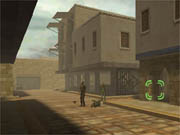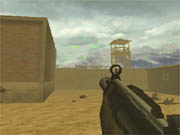Activision Value's new shooter, Shadow Force: Razor Unit, isn't even mentioned on the official Activision Value Web site. That's an implicit review you should probably trust, because, even judged against the somewhat threadbare standards of budget publishing, Shadow Force isn't real good.
Here's the online manual's description of the game:
"You are a member of the Air Force Special Operations Group. One of the elite Combat Controllers, responsible with everything from directing air strikes to controlling air traffic, you are ready to be sent in the Middle East. Trouble has arisen again over there, and you will support a team of Army Rangers."

It's a shame that the game part of the game never manages to be as entertaining as those three sentences. And in case you're wondering, you don't actually get to fight the arisen trouble with any shadowy air traffic controlling. You mainly run around 10 bland variations of a single desert level while shooting at the same two enemies.
Shadow Force was developed by Fun Labs, the Romanian software house responsible for the much better budget tactical shooter Secret Service. Although they share the same engine, Shadow Force isn't nearly as ambitious as Secret Service, nor does it feature that game's variety of environments. In fact, virtually every one of Shadow Force's environments and enemies appears to be constructed out of bits and pieces left over from Secret Service's first mission, which took place in a Middle Eastern city.
Secret Service's physics engine was one of its best parts, and it ends up being Shadow Force's only notable feature. The engine permits bodies to realistically interact with their surroundings. For instance, a fallen enemy might hang over a precipice for a few seconds before the weight of his body causes him to slide over the edge and tumble head over heels to the ground, the body's spin potentially getting intensified by an intervening clothesline. Bullets penetrate flimsy building materials. Objects in the world, such as barrels and furniture, are also governed by physics and tip over or break appropriately according to the amount of force being applied to them. Like most games that try to implement "real world" physics, nothing feels exactly solid. Everything's a little too lightweight, as if you're infiltrating the Middle Eastern section of the Moon. But it's as successful as any attempt made in a shooter, and it leads to some cool, unscripted moments.
Other than that, there isn't much to recommend about Shadow Force. It often seems like more of a rough draft of a game than a finished product. For example, halfway through one level, you have to escort an American soldier to the exit of one of the game's interchangeable environments. To get him to follow you, you have to put your aiming reticle over him and press the use key. Unfortunately, this command isn't mentioned anywhere in the manual, the readme file, the official Web site, the online help, or the training mission, though the training mission does instruct you in the use of a bunch of weapons that never really appear in the single-player campaign. This oversight is compounded by the fact that when you finally do press the use button on him, you're given absolutely no audio or visual cue that you just did something important. Pressing use again causes him to silently accept the unspoken command to stop following you, which can lead to more unpleasant confusion. And once he is following you, he doesn't do a very good job of it and often gets stuck in things like unobstructed, wide-open doorways. The enemies' artificial intelligence isn't a whole lot better--their one big trick is to run back and forth really fast, making them much harder to spray with bullets.
There are no memorable moments in Shadow Force. Even when something does seem about to happen, nothing happens. In one level, after fighting your way to a terrorist leader, you're told to hold your position and guard the prisoner until the Rangers arrive. Instead of actually "holding your position" in the not unreasonably expected "defending your position against attackers" sense, you honest to God just stand there with the guy for a few minutes until the level finally ends. It's a funny story, but not a terrific gameplay experience.

The sense that the game is unfinished extends to the multiplayer mode as well. There's no built-in server finder and no third-party server browser support, so finding a game is challenging enough that it could probably be an Olympic sport. There are bots, but they're so hidden that they might just be Easter eggs. To access them, you have to bring up the command console while already in a game and type a server command that adds them one at a time. Deathmatch, team deathmatch, and capture-the-flag modes are supported, though the bots don't know any of the rules of CTF.
Shadow Force will make you nostalgic for the relative salad days of Secret Service, so in some ways it's not a total loss for Fun Labs. Here's hoping it does better next time, though. In case you're still on the fence about this one, here's the review's secret shock ending: Shadow Force has no in-mission save!